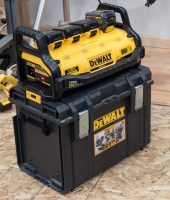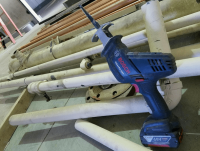One of the biggest hits at this year’s Milwaukee Tool New Product Symposium—from the plumbing department—was the new, self-priming M18 Transfer Pump. The Hub shot a Facebook Live video from the event and received more than 8,000 views within the first couple of hours of seeing a Read more
ProStaff Reviews


One of the biggest hits at this year’s Milwaukee Tool New Product Symposium—from the plumbing department—was the new, self-priming M18 Transfer Pump. The Hub shot a Facebook Live video from the event and received more than 8,000 views within the first couple of hours of seeing a demo for the first time.
Our ProStaffers were chomping at the bit to get their hands on one, so we sent it out to Bob ‘Hot Rod’ Rohr; Andy Mickelson, owner, Mickelson Plumbing & Heating; and the Hub’s Eric Aune, owner, Aune Plumbing LLC, for testing and review.
According to Rohr, the pump is well built and has nice fit and finish. “If weight—7.9 lbs.— equals quality, and the tool is properly used and maintained, this should be a coveted, long-lasting tool,” says Rohr. Aune and Mickelson agree, “The pump is lightweight compared to typical transfer pumps used on the job—cast iron usually,” says Aune.
“The weight is a big plus, as we are frequently packing our equipment though a house. This unit easily fits in a 5-gallon bucket with hoses for transportation,” says Mickelson.
The pump has a nice balance when carrying and using with one hand. Yet, says Aune, while the carry handle protects on/off switch, the handle makes it somewhat difficult to access the button. Rohr’s solution? If you hold the tool with your right hand, index finger towards the battery, “I found you can use the tip of your thumb to activate the switch. This frees up your left hand, and allows one-handed operation.”
The battery is protected under a hinged, tight fitting cover. Warranty is a generous—5 years. Performance on 5.0 battery, washer hoses, draining 50-gal H2O heater, for instance: 12 minutes—that’s fast, would be faster with larger hoses. Runtime on 9ah battery increases by almost 2x. “When paired with the 9.0 battery I see this being a very versatile tool, providing an exceptional run time for a cordless tool,” says Mickelson.
And, no additional cord to plug in is added value and makes jobs easier/faster.


Rohr says that he did not see any pump curve information included in the box. The spec sheet indicates 18’ maximum lift and up to 75’ head, or about 35 psi. (144 gallons per battery charge, about 20 minutes.)
The pump does run much louder when it is pumped dry, indicating it is time to power it down. Milwaukee indicates not over 10 seconds of dry run. The pump should shut down after 1 minute of dry run, via the battery technology.
Rohr considers the pump a flexible impeller style of pump, a design around since 1800s. Some refer to this style as a positive displacement-style pump also. Mickelson continues that even with mild system back pressure the pump does not spin backwards when turned off, acting as check valve almost. And Aune says that the impeller is replaceable. If left to run dry, it will need replaced at some point.
What about glycol? The instructions mentions clear water use only—note the 140°F maximum fluid temperature—so check with Milwaukee regarding glycols or GEO fluids. It is rated only for water but Aune Plumbing has pumped straight undiluted glycol and rinsed pump without problem. Mickelson pumped thick cold glycol with the pump and had great results thus far. “Perhaps if the pump is flushed with clear water after use this will be acceptable. Milwaukee mentions flushing with clear water should ‘anything but clear water be accidently pumped.’ For plumbing and HVAC use it needs to be able to handle the typical, clean heat transfer fluid, in my opinion,” says Rohr.
Funky Fittings?
If you want full performance from this pump, I’d suggest a 5/8 or 3/4” hoses, says Rohr. I did need to use a pliers to get a new hose to seal tightly, the threads seem a bit tight, time may wear these in so hand tightening is all that is required. Aune did notice some issues with the connections. “The hose fittings are odd in that some of my hoses will not tighten properly without wrench and effort,” says Aune.

UPDATE:
Since the original posting of this review Milwaukee has taken our concerns about the hose fittings to the product engineering team for a solution. Effective immediately all new transfer pumps have been fitted with hose adapters that work with a wider variety of hose connections.
On the Job
Hot Rod perched it on top of a 6-foot ladder and pumped from an open 5-gallon bucket. The pump primed instantly, first time out of the box. My first test was with a common washing machine-type hose, about 3/8 actual hose inside diameter. The operation manual does suggest a ¾” ID hose.
It took just under two minutes to empty the bucket, with the restrictive, off-the-shelf wash machine hoses. Pumping straight out of the pump, no hose on the discharge.
He then switched to a hose with a full 5/8” ID and the bucket emptied in 37 seconds! So at 6-ft. lift, wide-open discharge I measured just under 8 gallons per minute flow rate.
 His first job was to re-prime a siphon hose that fills a stock watering tank. The inlet end hose plugs with debris from the pond source from time to time. Rohr pumped clean water from a 5-gallon bucket into the siphon line to get the system flowing gain. This is one of the many tasks Rohr sees this cordless pump being used for around the shop.
His first job was to re-prime a siphon hose that fills a stock watering tank. The inlet end hose plugs with debris from the pond source from time to time. Rohr pumped clean water from a 5-gallon bucket into the siphon line to get the system flowing gain. This is one of the many tasks Rohr sees this cordless pump being used for around the shop.
Mickelson has flushed two tankless water heaters with this pump and he loves the self-prime feature. “The rubber impeller seems to be holding up nicely with the acid solution we use to clean the heaters. It also has shown no ill effects of pumping glycol or acid solutions.”
The techs at Mickelson Plumbing and Heating were able to pressurize a heating system with 33% propylene glycol to roughly 22 PSI with the pump. During this process we had pumped 30 gallons of fluid into the heating system, and purged the air out of the system with the pump for an additional 25 minutes, and the 9.0 battery still had 2 bars left on it!
The verdict
• Rohr: This should be a homerun for Milwaukee Tool. With the versatile M-18 battery pack, this useful pump should find it way on many service trucks.
• Aune: Easily the handiest pump for cleaning/flushing tankless water heaters I’ve ever used. Slam-dunk design and performance for the money. It’s not inexpensive but fits perfectly within the M18 platform, which is very popular in the plumbing/HVAC trades
• Mickelson — This model, less the battery is less money than the current transfer pumps that we use. Will be buying more cordless versions very shortly.
Finally, for the HVAC contractor, Rohr suggests this as a transfer pump for filling or topping off hydronic, geothermal or solar systems. Plumbers may find it ideal for empting water heaters, assuming the drain cock is not plugged. If so add a PEX dip tube from the top of the tank to prevent pulling sediment from the bottom drain valve.
Retail price:
$179.00 for bare tool
$279.00 for kit



The new FLEXVOLT system from Dewalt has opened up a whole new line of tools and possibilities for the pro contractor looking to get more done in less time. We’ve had a few of the FLEXVOLT tools at work in our shop and in the hands of the ProStaff team for a couple months now Read more
The new FLEXVOLT system from Dewalt has opened up a whole new line of tools and possibilities for the pro contractor looking to get more done in less time. We’ve had a few of the FLEXVOLT tools at work in our shop and in the hands of the ProStaff team for a couple months now and continue to be impressed. The latest is the DCB1800 Portable Power Station.
The power station is a combination 4-bank parallel battery charger and DC power inverter capable of providing 1800 watts continuous power at 15A with a peak power rating of 3600 watts 120v. That’s some serious power, this thing is sick.
There are a still a lot of tools on the job that haven’t lent well to cordless technology yet. Core drills, large demo hammers, compressors and various saws. Add to that the many contractors still using corded tools where upgrades either haven’t been in the budget or replacement of a perfectly good tool is unwarranted and you’ve got the need for portable power.
The DCB1800 power station is a portable generator running off (4) 20v MAX batteries, not a gas engine so indoor use is not a problem. The inverter is silent in comparison to any other portable power solution as well making it a non-factor where noise is a obstacle to getting the job done. This is a gamechanger for those looking to knock out some punch list items at the end of the job or quickly get in and out to complete a task with a corded tool when cordless isn’t available.
I wanted to get an idea of how much power this thing has so I loaded it up with (1) FLEXVOLT 20/60v MAX pack and (3) 20v MAX batteries, all new and fully charged and plugged my DW734 thickness planer in to it. I ran (14) 2×8 Fir boards thru the planer before losing power supply. The low power indicator lights started flashing after 10 boards, giving me four more complete before shutting down. That’s 112 feet of planing 2×8’s! I’d imagine ripping some plywood for backing or chipping with a rotary hammer for 20-30 minutes is within reach with a power supply like that. I’ll be putting this to the test on the job soon so stay tuned, for now check out video proof of my test:
https://youtu.be/bHT9eJi9cvM

Greetings everyone! Let me just say thank you to Mechanical Hub for reaching out to me for another tool review and inviting me to be on their new Pro Staff team! Since my early start in the Trades as a “Seasonal Helper” in residential plumbing and a Commercial HVAC installer to my now current full-time Read more
 Greetings everyone! Let me just say thank you to Mechanical Hub for reaching out to me for another tool review and inviting me to be on their new Pro Staff team! Since my early start in the Trades as a “Seasonal Helper” in residential plumbing and a Commercial HVAC installer to my now current full-time career as a Licensed Fire Sprinkler Fitter Foreman, I never thought I would be a part or involved with such a great opportunity and team. I’m grateful for all of it. Now let’s get down to this Bosch GSA18V-083B Reciprocating Saw review.
Greetings everyone! Let me just say thank you to Mechanical Hub for reaching out to me for another tool review and inviting me to be on their new Pro Staff team! Since my early start in the Trades as a “Seasonal Helper” in residential plumbing and a Commercial HVAC installer to my now current full-time career as a Licensed Fire Sprinkler Fitter Foreman, I never thought I would be a part or involved with such a great opportunity and team. I’m grateful for all of it. Now let’s get down to this Bosch GSA18V-083B Reciprocating Saw review.
 I was on a recent Retro fitting job for a major Grocery Chain moving into an existing shopping center. Part of my Job scope was the demo of now dead existing main and branch lines. The mains consisted of Schedule 10 and the branch line were threaded schedule 40. Normally we would go into the air with a 100’ cord hanging off the side of the lift (because the outlet was abused and dead in the lift) attached to a porta-band. This would be heavy and clumsy overhead use, as most time two hands are needed to hold the porta-band and try to balance the pipe being cut. So this time around I was excited and yet tempered my expectations to be able to use the Bosch GSA18V-083B Reciprocating Saw.
I was on a recent Retro fitting job for a major Grocery Chain moving into an existing shopping center. Part of my Job scope was the demo of now dead existing main and branch lines. The mains consisted of Schedule 10 and the branch line were threaded schedule 40. Normally we would go into the air with a 100’ cord hanging off the side of the lift (because the outlet was abused and dead in the lift) attached to a porta-band. This would be heavy and clumsy overhead use, as most time two hands are needed to hold the porta-band and try to balance the pipe being cut. So this time around I was excited and yet tempered my expectations to be able to use the Bosch GSA18V-083B Reciprocating Saw.
Some first impressions was that it was beefy yet manageable (4.4lbs) to hold and manipulate with one hand. The handle is large enough for different grips and rubber grips on both the back and front to avoid slipping, which is important when dealing with oil and water. The overall length without blade is 15-3/4” long. The trigger itself is large enough to be activated in most grips and angles. To be honest the look is uncanny identical to the Milwaukee M18 Cordless Hackzall Reciprocating Saw. Some nice features I noticed were the LED Light for the cutting zone and a lock out switch to prevent inadvertent startup.
Working with the Bosch GSA18V-083B I was provided with generic Bi-metal blades. So I already knew any cutting shortfalls could not all be shouldered by Bosch. The tool accepted the generic blades in its easy-to-operate blade-change system without problem. I decided to use the wireless charging batteries from the Bosch EC Brushless Socket-ready Impact Drill/Wrench (IDH182) that I previously reviewed. Maybe the staff will link that review here for you too. So when I previously stated that my expectations were tempered, it was because I expected the saw to fight or stall when cutting into steel. Whereas with a porta-band blade it has the finer teeth with a constant rpm and motion. To my surprise when cutting the 3” main it breezed right through. The schedule 10 steel was an easy cut for the generic blade and the Bosch. It was a nice little warm-up. Now with a little duller blade and a much thicker schedule of pipe, 40, I assumed when cutting I would get the snag and fight. In my head I would probably blame most of it on the cheapness of the bi-metal blade. Again Bosch impressed not only myself but my fellow Journeyman. A fast 3,050 strokes per minute was enough to handle said generic blade and about 12 cuts of 2” to 1-1/2” sched 40 pipe. On a side note; the battery lasted in power on one charge.
Overall in practicality and performance the Bosch GSA18V-083B Reciprocating Saw did the job. It was nice to be able to get into bar joists due to the compact design and make strategic cuts. The beefy weight was not too overwhelming for one handed grip cutting. The rpm was fantastic as it maximized material removal per stroke. The blade guard was not too bulky to get around the pipe and joist spaces. I can definitely see the potential for everyday general uses, and as far as job site use this tool is a must!






